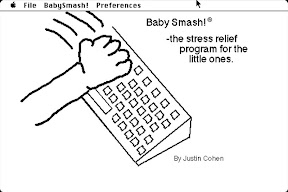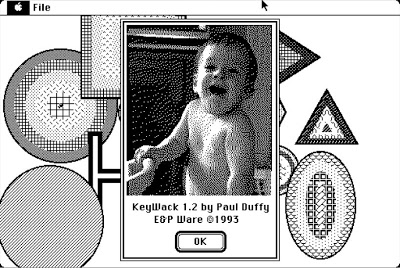This post has not been edited by the GamesBeat staff. Opinions by GamesBeat community writers do not necessarily reflect those of the staff.
Editor's note: How can you not click on a story with a headline like that? But before you call your local Fox affiliate, know that Baby Smash is not a game about smashing babies. It's actually part of a growing "key smashing" genre aimed at infants. Richard explains. -Brett

It’s remarkable how few games on the market target the "destructive infant" demographic. I’d go so far as to suggest that this has been the most under-represented group of gamers — apart from cats that like to sleep or walk on keyboards. But two ambitious Mac game developers attempted to cater to their needs in the early 1990s, and now, more than 15 years later, the key-smashing genre is rising to the fore.
Justin Cohen’s Baby Smash! and Paul Duffy’s KeyWack went head-to-head in cornering the market for random key-smashing games on the Mac in 1993, with each offering slightly different variations on what was essentially the same game. Both utilized built-in sound effects and pattern graphics from Macintosh System 7. Neither mapped specific keys to specific images or sounds. In fact, the only major difference between the two games was the means by which you could exit: Baby Smash required an awkward key combination, which was as difficult to remember as to accidentally press, while KeyWack asked you simply to have enough coordination to select “Quit” from the drop-down “File” menu.
Both provided gamers with a blank white screen to start with, although KeyWack kept the traditional Macintosh menu bar across the top. The goal — if you could call it such — was to either press random keys on the keyboard or click the mouse. Each input was met with immersive audio-visual feedback, such as an oval filled with a checkerboard pattern or the sound of a telephone.

The games were a remarkable leap forward in interactive entertainment for toddlers, though adults of more infantile levels of maturity could also appreciate their charm. Fart sounds, speech, pretty patterns, bright colors, drawings, shapes of various sizes and type, and bells and whistles of dozens of different frequencies are just some of the things that filled your screen and blasted out of your speakers.
KeyWack has since changed author and is now available for Mac, Windows, and Linux, with the added option to limit the display to sequential numbers or letters — useful for teaching counting and reading/reciting the alphabet through play. Baby Smash is unfortunately no longer in development.
Almost two decades later, though, the genre is beginning to thrive, with four products all vying for your toddler’s attention: the open-source AlphaBaby, donationware BabySplat, KeyWack, and a different, unaffiliated BabySmash, which is somewhat ironically Windows-only. AlphaBaby stands out among these as the most customizable, allowing you to easily add your own sounds and images for a personalized experience. It is also the only one of these products that has been made available for the iPhone and iPad, to the certain delight of many parents traveling with their toddlers.
These new key-smashing games lack some of the innocent charm of their predecessors, but more than make up for this with a greater range of shapes, colors, images, and sounds — especially AlphaBaby and KeyWack. And they’re sure to please parents whose children like to bang on the keyboard and mouse, with highly unpredictable results. Simply make sure one of these programs is running when your toddler is within reach of the keyboard and you will have peace of mind that your files, folders, and open documents are safe.

This was going to be an article about how I discovered KeyWack and Baby Smash on an old Mac CD-ROM called 1000 Games, finding them to be immensely charming. But when I was looking to see if they had newer versions I discovered that this is actually a genre in and of itself, which survives to this very day. So I changed my plan and ended up with the above article. Hope you like it.
